人皮下脂肪干细胞的成骨、成脂分化诱导及鉴定
人脂肪干细胞的体外培养鉴定及分化特性
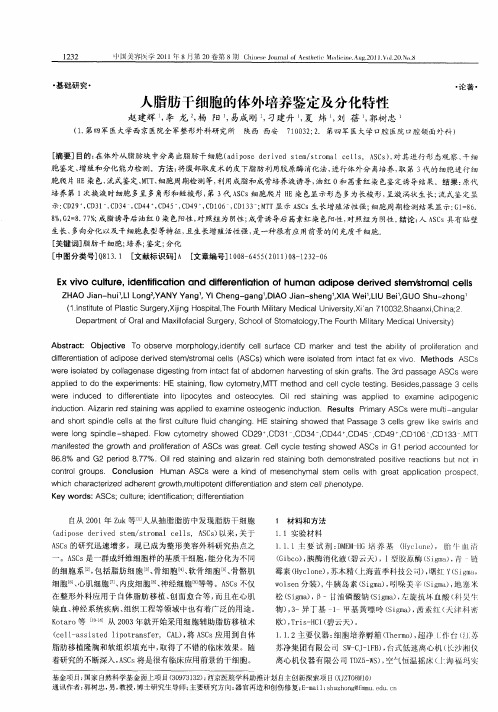
Ab ta t Obe t e o o s re mop oo yie ty c ls r c re n e tte a iy o poi rt n a d src: jci T b ev rh lg , ni el uf e CD mak ra d ts h bl f rl ai n v d f a i t f o e
ZHAO in uiL o  ̄ Ja —h ’ I ng, , L YANY Ya g , en — n ’ AO in s en ’ A e’ I iGUO n ’ YI Ch g ga g , DI Ja - h g , Xl W iL U Be’ , , Shu z n — ho g
E io cut e,den ic i n an f en i i n o um an ad p e der ed se Wsr x vv l ur i ti at d dier t o fh f o f at i os i v t r t om al el c l s
示 : D 9 ,D 1 ,D 4 ,D 4 , D 一C 4 C 1 6 ,D 3; T 示 A C 生 长增 殖 活 性 强 ; C 2 C 3 一C 3 C 4 C 4 , D 9 ,D 一C 1 一M T显 5 0 3 S s 细胞 周 期检 测 结 果 显 示 : 1 8. G=6
D p r n f a a d Ma i fca S rey S h o o tmaoo yT eF ut MiayMe ia U i ri ) e at t l n xl a il ug r, c o l f o tlg ,h o r l r me o Or l o S h i dc l n esy t v t
.
a pl d t o te e p r ns p i o d h x e i e me t:HE sann f w yo er , T me h d a d c lc ce t sig.B sd sp s a e 3 c l tiig, l c tm tyMT to n el y l e t o n e ie .a s g el s we e n c d o ie e t t it l o y e a d se c t s Oi e sann wa a pid o x mie dio e i r idu e t df r ni e no i c ts n o t o ye f a p I d t iig r s p l t e a n a p g nc e
干细胞诱导分化具体步骤及注意事项

干细胞诱导分化具体步骤及注意事项
一、技术简介
干细胞诱导分化是诱导干细胞定向分化,使之成为成熟的功能细胞,是目前干细胞研究的关键环节。
干细胞是一种未充分分化,具有自我复制能力的多潜能细胞,在一定条件下,它可以分化成多种功能细胞,具有再生各种组织器官和人体的潜在功能,医学界称为“万用细胞”。
如:骨髓间充质干细胞是位于骨髓基质中的一类中胚层来源的未分化细胞,在体内外均发现有极强的增殖能力,具有很强的自我更新和多向分化潜能。
在一定诱导条件下,可以分化为成骨细胞、成软骨细胞和成肌细胞等,还可以分化为巨噬细胞、脂肪细胞、内皮细胞和成纤维细胞等骨髓基质细胞,具有发育为骨、软骨、脂肪、肌肉、真皮及骨髓基质等中胚层组织的潜能。
在体胚胎分化过程中,组织发生和身体构造的形成具有时空顺序性和相互诱导性。
在个体发育过程中,细胞分化是程序控制的有序有规律过程,程序的运行结果表现为不同发育阶段、不同组织部位的细胞表现出不同的形态、不同的生长方式和不同的生理功能。
从分子水平上来看,这一结果取决于细胞在基因表达上的时空差异,这种基因表达差异除由细胞内在发育程序决定外,还受细胞外环境影响和调控,且有时这种外部控制条件或环境对形成特定细胞有着决定性作用。
干细胞体外定向诱导分化的原理,就是选择适当的诱导剂和诱导模式,通过诱导物与细胞表面受体结合或使细胞发生轻度可逆性损伤等,使被诱导细胞按预定的细胞类型方向分化,然后将这些定向分化的细胞进行分离和培养传代,从而得到人们所需要的细胞类型。
二、实验流程
1. 干细胞的分离、原代和传代培养。
2. 定向诱导干细胞分化。
3. 成长曲线测定。
4. 诱导分化后细胞鉴定。
5. 结果统计分析。
人脂肪干细胞的分离、培养及鉴定

人脂肪干细胞的分离、培养及鉴定李玉秋;张雷雷;黄飞【摘要】目的:探讨胶原酶消化法从人脂肪组织中提取脂肪干细胞(adipose-derived stem cells,ADSCs)的可行性.方法:采用胶原酶消化法将真空抽脂术抽取的新鲜脂肪组织进行消化分离,获取ADSCs并进行培养,用流式细胞术鉴定ADSCs的表面特异性标志物CD34、CD44、CD45、CD105的表达.结果:利用胶原酶消化法可成功提取ADSCs,其标志物CD44和CD105表达阳性,CD34为低表达,CD45表达为阴性.结论:通过胶原酶法可成功提取人ADSCs.【期刊名称】《沈阳医学院学报》【年(卷),期】2018(020)006【总页数】4页(P495-498)【关键词】人脂肪干细胞;细胞分离;细胞培养;细胞鉴定【作者】李玉秋;张雷雷;黄飞【作者单位】山东华思生物科技有限公司,山东烟台 264003;山东华思生物科技有限公司,山东烟台 264003;山东华思生物科技有限公司,山东烟台 264003【正文语种】中文【中图分类】R329.2脂肪干细胞(adipose-derived stem cells,ADSCs)是2001年Zuk等[1]从真空吸脂术抽出的脂肪中发现的一种间充质干细胞(mesenchymal stem cells,MSCs),其含量约占脂肪组织的10%~20%[2]。
ADSCs同其他MSCs一样,具有自我更新和多向分化的潜能,是成体干细胞的一种,在疾病治疗领域有巨大的潜力。
但ADSCs较骨髓干细胞有更高的提取率,其提取率可高达1%~2%,是骨髓干细胞的1 000倍[3]。
ADSCs已成为研究者们青睐的种子细胞,本文就ADSCs的提取、培养和鉴定进行研究。
1 材料与方法1.1 材料1.1.1 脂肪组织选取滨州医学院附属医院产科剖宫产产妇皮下脂肪组织,产妇无其他基础疾病,未经过特殊药物治疗,取材前均获得医院伦理委员会批准和产妇知情同意。
脂肪干细胞成脂诱导及鉴定程序

脂肪干细胞成脂诱导及鉴定程序一、试剂准备(一)成脂分化诱导液(Adipogenic Medium, AM)配方【1】:试剂名称浓度商品信息1.极限必须培养基(Dulbecco’S Modified Eagle Medium ,DMEM) 1.0 L(SH30021.01B, Hyclone)2.胎牛血清(Fetal Bovine Serum,FBS)10%(ES-009-B, Millipore)3.青霉素/链霉素(Penicillin/Streptomycin)1%(TMS-AB2C, CHEMICON)4.地塞米松(Dexamethasone,DM) 1µmo/L 分子量:392.46(D4902-25MG, Sigma)5.胰岛素(Insulin, IS) 10 µmol/L 分子量:5808(91077C—1g, Sigma)6.3-异丁基-1-甲基黄嘌呤(Isobutylmethylxanthine,IBMX) 0.5 mmol/L 分子量:222.24( I5879-100MG, Sigma)7.吲哚美辛(Indomethacin,ID) 200 µmol/L 分子量:357.79(I7378—5G, Sigma)(二)成脂分化诱导液浓储液配制试剂名称质量浓缩倍数配制方法1.Stock A胎牛血清1ml/管1X( liquid)分装1ml/管X100 保存:-20℃2.Stock B青霉素/链霉素0.1ml/管100X( liquid)分装0.1ml/管X100 保存:-20℃3.Stock C地塞米松0.0117738 g 1000X 溶于30ml 无水乙醇(0.1%) 分装0.1ml/管X300保存:-20℃4.Stock D胰岛素0.05808 g100X 溶于10ml Hcl(0.1 mol/L,PH2.0) 分装0.1ml/管X100保存:4℃5.Stock E3-异丁基-1-甲基黄嘌呤0.05556 g 200X 溶于2.5ml DMSO(0. 5%) 分装0.05ml/EP管X50 保存:-20℃6.Stock F吲哚美辛0.07155 g 500X 溶于2ml 无水乙醇(0.2%) 分装0.02ml/管X100保存:-20℃(三)成脂分化诱导液工作液配制(10ml)1.取DMEM(L)8.72ml加入15ml离心管(BD);2.加1管Stock A(1ml);3.加1管Stock B(0.1ml);4.取1管Stock C(0.1ml)溶解,加入0.01ml;5.加1管Stock E(0.05ml);6.加1管Stock F(0.02ml);7.加1管Stock D(0.1ml);8.测渗透压,调pH7.2-7.4;9.0.22µm微孔过滤,4℃贮存,一周内使用。
脂肪干细胞成脂分化的分子机制和信号通路
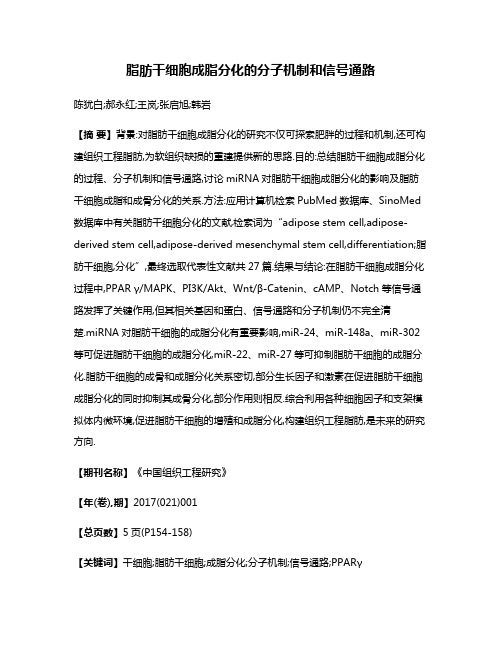
脂肪干细胞成脂分化的分子机制和信号通路陈犹白;郝永红;王岚;张启旭;韩岩【摘要】背景:对脂肪干细胞成脂分化的研究不仅可探索肥胖的过程和机制,还可构建组织工程脂肪,为软组织缺损的重建提供新的思路.目的:总结脂肪干细胞成脂分化的过程、分子机制和信号通路,讨论miRNA对脂肪干细胞成脂分化的影响及脂肪干细胞成脂和成骨分化的关系.方法:应用计算机检索PubMed数据库、SinoMed 数据库中有关脂肪干细胞分化的文献,检索词为“adipose stem cell,adipose-derived stem cell,adipose-derived mesenchymal stem cell,differentiation;脂肪干细胞,分化”,最终选取代表性文献共27篇.结果与结论:在脂肪干细胞成脂分化过程中,PPAR γ/MAPK、PI3K/Akt、Wnt/β-Catenin、cAMP、Notch等信号通路发挥了关键作用,但其相关基因和蛋白、信号通路和分子机制仍不完全清楚.miRNA对脂肪干细胞的成脂分化有重要影响,miR-24、miR-148a、miR-302等可促进脂肪干细胞的成脂分化,miR-22、miR-27等可抑制脂肪干细胞的成脂分化.脂肪干细胞的成骨和成脂分化关系密切,部分生长因子和激素在促进脂肪干细胞成脂分化的同时抑制其成骨分化,部分作用则相反.综合利用各种细胞因子和支架模拟体内微环境,促进脂肪干细胞的增殖和成脂分化,构建组织工程脂肪,是未来的研究方向.【期刊名称】《中国组织工程研究》【年(卷),期】2017(021)001【总页数】5页(P154-158)【关键词】干细胞;脂肪干细胞;成脂分化;分子机制;信号通路;PPARγ【作者】陈犹白;郝永红;王岚;张启旭;韩岩【作者单位】解放军总医院整形修复科,北京市 100853;美国德克萨斯大学MD安德森肿瘤中心整形外科,美国休斯敦770303;解放军总医院皮肤科,北京市 100853;解放军总医院皮肤科,北京市 100853;美国德克萨斯大学MD安德森肿瘤中心整形外科,美国休斯敦770303;解放军总医院整形修复科,北京市 100853【正文语种】中文【中图分类】R318文题释义:过氧化物酶体增殖物激活受体γ(peroxisome proliferator-activated receptor γ, PPARγ):PPAR对脂肪细胞分化和脂质代谢有重要的调节作用,PPAR包括PPARα、PPARβ和PPARγ三种亚型,其中PPARγ在脂肪组织中特异性高表达,是脂肪干细胞成脂分化的关键转录因子。
人皮下脂肪干细胞的成骨、成脂分化诱导及鉴定

人皮下脂肪干细胞的成骨、成脂分化诱导及鉴定肖建红;张阳春;张常然;杨兴【摘要】背景:脂肪干细胞是从脂肪组织中分离得到的一种具有多向分化潜能的间充质干细胞,在组织工程中比骨髓间充质干细胞具有更多优势,是当今的研究热点之一。
<br> 目的:在体外建立一种分离纯化人皮下脂肪来源脂肪干细胞的方法,进行体外培养扩增及诱导其向成骨、成脂细胞分化。
<br> 方法:通过密度梯度离心和贴壁筛选法相结合,对人脂肪干细胞进行分离、体外培养及扩增。
倒置显微镜下观察人脂肪干细胞的细胞形态和生长特性。
选取第2代及第5代细胞,用CCK-8法检测细胞活性,绘制细胞生长曲线,用流式细胞仪检测细胞表面抗原标记。
选取第5代细胞,分别进行成脂及成骨诱导分化,以确定其多向分化潜能。
<br> 结果与结论:①采用密度梯度离心和贴壁培养相结合方法,可成功从人脂肪组织中获得纯度较高的人脂肪干细胞。
②人脂肪干细胞经历了生长滞缓期、对数增殖期和生长平台期,符合正常细胞的生长规律,且其生长具有对数生长期,其倍增时间较短。
③人脂肪干细胞表达干细胞表面抗原标记,具有低免疫原性,且具有成脂成骨多向分化潜能。
④DAPI是一种简单、有效的标记人脂肪干细胞的方法,DAPI不损伤细胞活性,对细胞标记率高。
%BACKGROUND:Adipose-derived stem cels are a kind of mesenchyam stem cels with multipotent differentiation capacity, which have more advantages than bone marrow mesenchymal stem cels in tissue engineering research. OBJECTIVE: To establish a method to isolate and purify adipose-derived stem cels from human subcutaneous adipose tissues folowed byin vitro amplification and osteoblastic/adipogenic differentiation. <br> METHODS: Adipose-derived stem cels were isolated from human subcutaneous adipose tissue andcultured by density gradient centrifugation and adherent culture. Cel morphology and growth features were observed under inverted microscope. Adipose-derived stem cels at passages 2 and 5 were selected for viability measurement using cel counting kit-8 method, and then cel growth curves were drawn. The immunophenotype identification was analyzed by flow cytometry. Passage 5 cels underwentosteoblastic/adipogenic induction to confirm the multi-differentiation potential. <br> RESULTS AND CONCLUSION: (1) Using density gradient centrifugation and adherent culture method, high-purity human adipose-derived stem cels can be successfuly isolated from human adipose tissues.(2) The growth process of human adipose-derived stem cels includes stagnant phase, logarithmic phase and plateau phase, which meets the growth rhythm of normal cels. Moreover, the population doubling time is shorter. (3). Human adipose-derived stem cels are positive for stem cel-related antigens, with low immunogenicity and the multi-differentiation potential. (4) Labeling human adipose-derived stem cels with DAPI is a simple efficient labeled method, and the labeling rate is high but the cytotoxicity is low【期刊名称】《中国组织工程研究》【年(卷),期】2015(000)032【总页数】7页(P5155-5161)【关键词】干细胞;脂肪干细胞;人来源的脂肪干细胞;细胞分化;脂肪组织;细胞培养;细胞鉴定;国家自然科学基金【作者】肖建红;张阳春;张常然;杨兴【作者单位】中山大学附属第一医院东院普通内科,广东省广州市 510700;中山大学附属第一医院东院下肢骨科,广东省广州市 510700;中山大学附属第一医院东院普通内科,广东省广州市 510700;中山大学附属第一医院东院下肢骨科,广东省广州市 510700【正文语种】中文【中图分类】R394.2文章亮点:1 实验通过密度梯度离心和贴壁筛选法相结合,对人脂肪干细胞进行分离、体外培养及扩增。
人脂肪间充质干细胞的原代培养及体外成骨成脂诱导分化
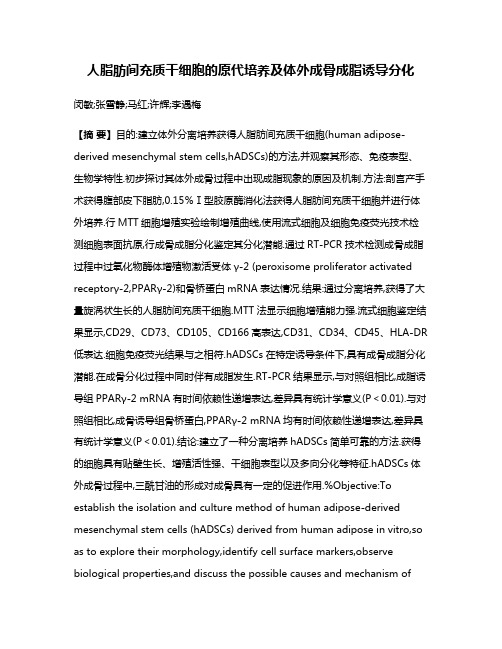
人脂肪间充质干细胞的原代培养及体外成骨成脂诱导分化闵敏;张雪静;马红;许辉;李遇梅【摘要】目的:建立体外分离培养获得人脂肪间充质干细胞(human adipose-derived mesenchymal stem cells,hADSCs)的方法,并观察其形态、免疫表型、生物学特性.初步探讨其体外成骨过程中出现成脂现象的原因及机制.方法:剖宫产手术获得腹部皮下脂肪,0.15%Ⅰ型胶原酶消化法获得人脂肪间充质干细胞并进行体外培养.行MTT细胞增殖实验绘制增殖曲线,使用流式细胞及细胞免疫荧光技术检测细胞表面抗原,行成骨成脂分化鉴定其分化潜能.通过RT-PCR技术检测成骨成脂过程中过氧化物酶体增殖物激活受体γ-2 (peroxisome proliferator activated receptorγ-2,PPARγ-2)和骨桥蛋白mRNA表达情况.结果:通过分离培养,获得了大量旋涡状生长的人脂肪间充质干细胞.MTT法显示细胞增殖能力强.流式细胞鉴定结果显示,CD29、CD73、CD105、CD166高表达,CD31、CD34、CD45、HLA-DR 低表达.细胞免疫荧光结果与之相符.hADSCs在特定诱导条件下,具有成骨成脂分化潜能.在成骨分化过程中同时伴有成脂发生.RT-PCR结果显示,与对照组相比,成脂诱导组PPARγ-2 mRNA有时间依赖性递增表达,差异具有统计学意义(P<0.01).与对照组相比,成骨诱导组骨桥蛋白,PPARγ-2 mRNA均有时间依赖性递增表达,差异具有统计学意义(P<0.01).结论:建立了一种分离培养hADSCs简单可靠的方法.获得的细胞具有贴壁生长、增殖活性强、干细胞表型以及多向分化等特征.hADSCs体外成骨过程中,三酰甘油的形成对成骨具有一定的促进作用.%Objective:To establish the isolation and culture method of human adipose-derived mesenchymal stem cells (hADSCs) derived from human adipose in vitro,so as to explore their morphology,identify cell surface markers,observe biological properties,and discuss the possible causes and mechanism ofthe phenomenon of hADSCs' osteogenic differentiation accompanying with synthesis of triglycerides.Methods:Human adipose tissue were obtained from abdominal operation.The hADSCs were isolated from human adipose tissue by 0.15% collagenase digesting.The cells were applied to do the experiments:MTT method,flowcytometry,immunofluorescence.Its differentiation potential was proved by osteogenic and adipogenic differentiation.The osteogenic and adipogenic related genes:PPARγ-2,osteopontin expression were detected by real-time fluorescent quantitative PCR technique.Results:After isolation and culture,we obtained a large amount of hADSCs,which grew like swirls.MTT revealed high capability for and proliferation.The flow cytometry showed CD29 +,CD31-,CD34-,CD45-,CD73 +,CD105 +,CD166 +,HLA-DR-,which fit the results of immuno fluorescence.Moreover,these cells could be functionally induced into adipocytes and osteoblasts in the presence of appropriate conditioned media.During osteogenic differentiation,we found it accompanying with the synthesis of triglycerides.RT-PCR results proved that during the differention process,osteogenic and adipogenic related genes began to be expressed gradually,which had statistically significant(P <0.01).Conclusion:Highly efficient isolation and cultivation methods for hADSCs have been developed.They are a kind of mesenchymal cells with great application prospect,which characterized with adherent growth,high proliferation,stem cell phenotype and multipotent differentiation.During vitro osteogenic differentiation,the triglyceride formation has a certain role in promoting osteogenesis.【期刊名称】《江苏大学学报(医学版)》【年(卷),期】2013(023)003【总页数】6页(P185-190)【关键词】人脂肪间充质干细胞;鉴定;成骨分化;成脂分化【作者】闵敏;张雪静;马红;许辉;李遇梅【作者单位】江苏大学附属医院皮肤科,江苏镇江212001;镇江市第二人民医院皮肤科,江苏镇江212002;江苏大学附属医院皮肤科,江苏镇江212001;江苏大学附属医院皮肤科,江苏镇江212001;江苏大学附属医院皮肤科,江苏镇江212001【正文语种】中文【中图分类】R329.2对于间充质干细胞的研究,最初的对象是骨髓间充质干细胞,并且已经形成了成熟的分离培养方法[1]。
《人脂肪干细胞(ADSCs)的分离培养及多向分化潜能研究》范文

《人脂肪干细胞(ADSCs)的分离培养及多向分化潜能研究》篇一一、引言人脂肪干细胞(ADSCs)作为一种重要的细胞资源,近年来在医学和生物学领域中引起了广泛关注。
这种细胞类型不仅在临床医学上被广泛应用于治疗各种疾病,同时在科学研究领域,它的多向分化潜能及生物机制也是备受瞩目的研究方向。
本文就人脂肪干细胞的分离培养方法和多向分化潜能的研究进行了系统性的探讨。
二、人脂肪干细胞的分离培养1. 分离方法人脂肪干细胞的分离主要依赖于酶解法。
首先,从供体脂肪组织中获取足够的细胞,通过使用含有特定酶的溶液(如胶原酶)来分解脂肪组织,使ADSCs得以释放。
随后,通过离心和筛选过程,获取纯度较高的ADSCs。
2. 培养方法ADSCs的体外培养通常使用含有生长因子和营养物质的特殊培养基。
这些培养基提供了细胞生长所需的营养和环境条件。
在培养过程中,应定期更换培养基,以确保细胞持续得到所需的营养供给。
同时,也需要关注细胞的生长状况和活力。
三、多向分化潜能研究1. 分化为成骨细胞ADSCs具有分化为成骨细胞的能力,这一过程可以通过添加适当的诱导剂和调节生长因子来实现。
在分化过程中,可以通过观察细胞的形态变化和特定基因的表达情况来评估其分化的程度和效果。
2. 分化为成脂细胞ADSCs还可以分化为成脂细胞,这一过程可以通过调整培养基中的营养成分和生长因子来实现。
成脂细胞的分化可以通过观察细胞的脂滴形成和特定基因的表达情况来评估。
3. 分化为神经细胞除了成骨细胞和成脂细胞外,ADSCs还具有向神经细胞分化的潜能。
这一过程可以通过特定的诱导剂和培养条件来实现。
对分化后的神经细胞进行功能测试和基因表达分析,可以评估其分化的效果和潜能。
四、结论通过对人脂肪干细胞的分离培养和多向分化潜能的研究,我们可以更好地了解这种细胞的特性和功能。
ADSCs的分离培养方法已经相对成熟,使得我们可以获取大量的细胞进行后续研究。
同时,ADSCs的多向分化潜能也为临床治疗提供了新的可能性和思路。
脂肪干细胞成脂诱导及鉴定程序

1.0 L(SH30021.01B, Hyclone) 2. 胎牛血清( Fetal Bovine Serum ,FBS)10%1%1 pmo/ L10 mol / L黄嘌呤0.5 mmol/L200 mol / L (ES-009-B, Millipore)(TMS-AB2C, CHEMICON ) 分子量:392.46(D4902-25MG, Sigma)分子量:5808(91077C—1g, Sigma)分子量:222.24( I5879-100MG, Sigma)分子量:357.79(I7378 —5G, Sigma)脂肪干细胞成脂诱导及鉴定程序、试剂准备一)成脂分化诱导液(Adipogenic Medium, AM )配方【1】:试剂名称浓度商品信息1. 极限必须培养基(Dulbecco 'S Modified Eagle Medium,DMEM)二)成脂分化诱导液浓储液配制试剂名称f=p 曰.质量浓缩倍数配制方法1. Stock A 分装1ml/管X100胎牛血清1ml/ 管1X( liquid )保存:-20C2. Stock B 分装0.1ml/管X100青霉素/ 链霉素0.1ml/ 管100X( liquid )保存:-20C3. Stock C 溶于30ml 无水乙醇(0.1%)地塞米松0.0117738 g 1000X 分装0.1ml/管X300保存:-20C4. Stock D 溶于10ml Hcl(0.1 mol/L ,PH2.0)胰岛素0.05808 g 100X 分装0.1ml/管X100保存:4C5. Stock E 溶于 2.5ml DMSO(0. 5%)3-异丁基-1 -甲基黄嘌呤0.05556 g 200X 分装0.05ml/EP 管X50保存:-20C6. Stock F 溶于2ml 无水乙醇(0.2%)吲哚美辛0.07155 g 500X分装0.02ml/ 管X100 保存:-20C (三)成脂分化诱导液工作液配制(10ml)1. 取DMEM(L)8.72ml 加入15ml 离心管(BD )2. 加1 管Stock A(1ml);3. 加1 管Stock B(0.1ml);4. 取1 管Stock C (0.1ml)溶解,加入0.01ml ;5. 加1 管Stock E(0.05ml);6. 加1 管Stock F (0.02ml);7. 加1 管Stock D (0.1ml);8. 测渗透压,调pH7.2-7.4;9. 0.22 m微孔过滤,4C贮存,一周内使用。
干细胞成骨、成脂、成软骨诱导分化及检测

⼲细胞成⾻、成脂、成软⾻诱导分化及检测三个⽅向诱导分化诱导⾻髓间充质⼲细胞成软⾻分化⼀、诱导⽅法将细胞悬液置于 50 mL聚苯⼄烯培养瓶(Nunclon)中培养。
完全培养基中加⼊能诱导MSCs 向软⾻细胞转化的诱导因⼦: (⼀致统⼀的诱导物质)转化⽣长因⼦β1 10ng/ml,(左旋)维⽣素 C 50 mg/L(也有0.1mmol/L)地塞⽶松 0.1nmol/L (也有10 nmol/L)ITS 50mg/ml丙酮酸钠 1mmol/L亚油酸 5.35ug/mg⽜⾎清⽩蛋⽩ 1.25ng/ml。
倒置显微镜逐⽇(1-3 weeks)观察细胞⽣长情况。
细胞长成单层后进⾏传代。
细胞培养3周。
去除培养液,晾⼲,①细胞⽤通⽤Ⅱ型胶原检测试剂盒(晶美⽣物⼯程有限公司) 免疫组化,按试剂盒说明书操作;②⽤alcian blue 孵育5 min, 流⽔冲洗2 min ,麦⽒苏⽊素复染5 min ,流⽔冲洗2 min ,晾⼲,显微镜下观察细胞的蛋⽩聚糖沉积。
或者⽤甲苯胺蓝染⾊,具体我也没做过,查到⼀篇⽂章中是这么说的:MSC成软⾻诱导后的甲苯胺蓝染⾊检测:培养不同时间的MSC培养⽫倒掉诱导培养液,10%甲醛固定lh,⾃来⽔冲洗15min,双蒸⽔冲洗1次,滴加1%甲苯胺蓝染液于培养⽫内,染⾊3h,加⼈95%⼄醇,洗去多余的染液,烘⼲,中性树胶封⽚。
诱导⾻髓间充质⼲细胞成⾻⽅向分化成⾻诱导培养: 取第 3代细胞, 接种⼊含体积分数为0.1 的新⽣⽜⾎清、0.1 µmol/L 地塞⽶松、50 µmol/L 抗坏⾎酸、10 mmol/L β- ⽢油磷酸钠的⾼糖 DMEM培养基进⾏成⾻诱导培养, 进⾏形态观察、功能检测。
间充质⼲细胞成⾻特性检测:①碱性磷酸酶组织化学染⾊:取成⾻诱导 14 d 的细胞 , 40 g/L 中性甲醛固定 15 min, Gomori改良钙钴法染⾊。
取 5 块玻⽚, 每⽚随机取 2个视野, 采⽤⽹格计数法, 计算碱性磷酸酶染⾊阳性细胞的百分⽐。
人脂肪干细胞的分离和成脂诱导及鉴定

13BIOTECHWORLD 生物技术世界1 前言间充质干细胞是由一组不同分化潜能的细胞组成的。
MSC存在于多种组织,主要包括骨髓、脂肪组织、骨骼肌、肝脏、皮肤结缔组织、胚胎组织、脐带、脐血及外周血等。
由于MSC具有多向分化潜能,在一定实验条件诱导下可向不同胚层的细胞分化[1]。
2001年,Zuk [2]等从抽脂术废弃的脂肪组织中,分离出脂肪干细胞,并证明这种丰富且能再生的组织可作为未来组织工程的细胞来源。
体外实验显示在特定培养条件下,MSC可分化为中胚层起源的成骨细胞、软骨细胞、脂肪细胞、骨骼肌细胞、心肌细胞等。
本文通过体外培养的方法从脂肪组织中筛选出ADSCs [3],进一步研究脂肪干细胞体外分离培养的方法,并进行染色和表面抗原鉴定,为ADSCs 相关研究提供参考。
2 材料与方法:2.1 样品来源:人腹部抽脂50ml 2.2 试剂PBS(磷酸盐缓冲液),Hyclone;DMEM/F-12 1:1,Hyclone;0.1% I型胶原酶;Ul troser-G,PALL;L-Glu ,GIBCO;0.25%胰酶,Life;地塞米松, SIGMA;IBMX(3-异丁基-1-甲基黄嘌呤);油红O;异丙醇;75%酒精。
2.3 ADSCs 分离和培养收集脂肪组织后,加入等体积的PBS,2000rpm,5min离心,吸弃中间盐水层,保留上层脂肪层和下层沉淀,重复离心2遍,保留上层脂肪层和下层沉淀细胞。
向含有脂肪层的离心管中加入等体积的0.1%I型胶原酶,37℃,水浴8min,加入等体积PBS 终止消化,2000rpm,5min离心,吸弃中间盐水层,保留上层脂肪层和下层沉淀,重复消化离心3遍,最后弃去上层脂肪层。
将两次收集到的沉淀合并,用PBS洗一次,离心弃上清。
用注射用水裂解红细胞,离心收集沉淀。
取3×106个细胞接种到T175 cm 2 细胞培养瓶中,用含有2% Ul troser-G和1% L-Glu的DMEN/F-12培养,24h,次日收集细胞液,下层贴壁细胞为成纤维细胞,将细胞液重新接种到新的T175 cm 2 细胞培养瓶中,隔三天换液一次,培养期间根据细胞生长情况传代,培养到第14天时收获细胞[4]。
人脂肪来源干细胞的分离、培养及成骨分化的研究

骨 诱 导分 化 , 为 临 床 骨 组 织 重 建 提 供 种 子 细 胞 。方 法
组 织 中提 取 h AS C s 。 MT S法 绘 制 h A S C s 生长 曲线 ; 利用 流式细胞 术检 测 h AS C s 表 面标 志 ; 以低糖 D ME M含 1 O
F B S及 1 青/ 链 霉 素 为基 础 培 养 基 , 含l n M 地塞米松 , 1 0 mM 磷 酸 甘 油 , 0 . 0 5 mM 维 生 素 C的 条 件 培 养 基 连 续 培 养
b r o s i s [ J ] . Am J P h y s i o l R e n a l P h y s i o l , 2 0 0 2 , 2 8 2 ( 3 ) : 4 3 1 . [ 1 3 ] P a t e l S , D o b l e B, Wo o d g e t t J R . Gl y c o g e n s y n t h a s e k i n a s e 一 3 i n i n —
文章编 号 : 1 0 0 7 —4 2 8 7 ( 2 0 1 3 ) 0 4 —0 6 3 9 —0 5
人 脂 肪 来 源 干 细胞 的分 离 、 培 养 及 成 骨 分 化 的研 究
赵 强 , 吕 爽 , 翟 颖仙。 , 高振 平 。 , 石 英 爱。
( 吉林 大 学 l _ 第一临床医 院 儿外科 , 吉林长春 1 3 0 0 2 1 ; 2 . 白求 恩 医 学 院 病 理 生 物 学 教 育部 重 点 研究 室 ; 3 . 白求恩医学院 解剖教研室 )
[ 1 2 ] S u r e n d r a n K, Mc C a u l S P, S i mo n T C . A r o l e f o r Wn t 4 i n r e n a l f i —
干细胞成骨和成脂诱导方法
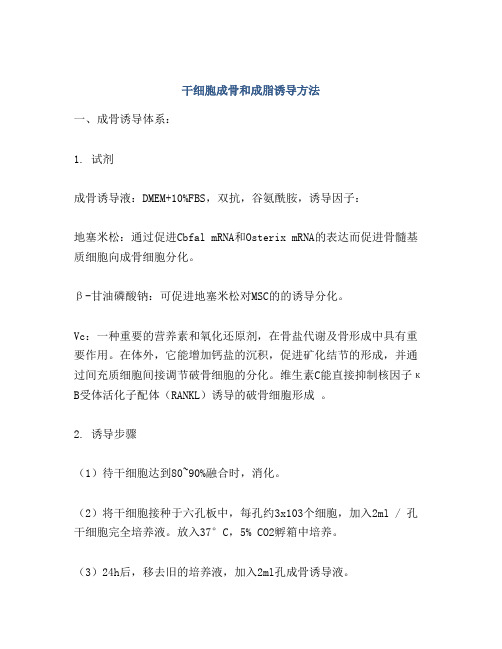
干细胞成骨和成脂诱导方法一、成骨诱导体系:1. 试剂成骨诱导液:DMEM+10%FBS,双抗,谷氨酰胺,诱导因子:地塞米松:通过促进Cbfal mRNA和Osterix mRNA的表达而促进骨髓基质细胞向成骨细胞分化。
β-甘油磷酸钠:可促进地塞米松对MSC的的诱导分化。
Vc:一种重要的营养素和氧化还原剂,在骨盐代谢及骨形成中具有重要作用。
在体外,它能增加钙盐的沉积,促进矿化结节的形成,并通过间充质细胞间接调节破骨细胞的分化。
维生素C能直接抑制核因子κB受体活化子配体(RANKL)诱导的破骨细胞形成。
2. 诱导步骤(1)待干细胞达到80~90%融合时,消化。
(2)将干细胞接种于六孔板中,每孔约3x103个细胞,加入2ml / 孔干细胞完全培养液。
放入37°C,5% CO2孵箱中培养。
(3)24h后,移去旧的培养液,加入2ml孔成骨诱导液。
(4)每三天换液,诱导2-3周。
(5)2-3周后,钙结节形成,进行茜素红染色。
二、成脂诱导体系:1. 试剂成脂诱导液A:DMEM+10%FBS,双抗,谷氨酰胺,诱导因子:胰岛素,I BMX,地塞米松,吲哚美锌。
成脂诱导液B:DMEM+10%FBS,双抗,谷氨酰胺,诱导因子:胰岛素。
2. 诱导步骤:(1)待干细胞达到80~90%融合时,消化。
(2)将干细胞接种于六孔板中,每孔约2x104个细胞,加入2ml / 孔干细胞完全培养液。
放入37°C,5% CO2孵箱中培养。
(3)每三天进行换液(干细胞完全培养液),直至细胞达到100%融合。
(4)待细胞达到100%融合时,移去旧的培养液,加入2ml / 孔成脂诱导液A开始诱导。
(5)三天后更换成成脂诱导液B进行维持,24h后再更换成成脂诱导液A诱导,如此进行3个循环。
(6)当脂滴出现较多,但比较小时,可以用成脂诱导液B进行维持3-5天,脂滴增大。
(7)油红O染色。
人脂肪干细胞的提取和鉴定

人脂肪干细胞的提取和鉴定吴尉;梁芳;宋小琴;胡平安;刘敏【摘要】BACKGROUND:Adipose-derived stem cel s are totipotent stem cel s in the adipose tissue, and have the function of self-renewal and multi-directional differentiation. Human adipose-derived stem cel s are ideal seed cel s with stable genetic milieu and few rejections. <br> OBJECTIVE:To extract human adipose-derived stem cel s from human omental adipose tissue and to identify the cel s by adipogenic and osteogenic induction. <br> METHODS:Omental adipose tissues were col ected from surgical patients to isolate and culture adipose-derived stem cel s using type I col agenase digestion, filtration and centrifugation. Cel growth was observed and proliferative curve of human adipose-derived stem cel s were drawn by cel counting method to calculate the doubling time at logarithmic growth phase. After adipogenic and osteogenic induction, induced cel s were identified using oil red O and alizarin red staining, respectively. <br> RESULTS AND CONCLUSION:Human adipose-derived stem cel s were successful y isolated from the omentum tissues of surgical patients. Adherent cel s were fusiform-shaped and like fibroblasts. The growth curve of passage 3 cel s was in S shape, and the doubling time was 45.90 hours. After adipogenic and osteogenic induction for 2 and 3 hours, respectively, oil red O staining showed unequal-sized orange fat droplets, and alizarin red staining showed typical calcified nodules that were in orange. These findings indicate that adipose-derived stemcel s have the adipogenic and osteogenic capacity.%背景:脂肪干细胞是存在于脂肪中的全能干细胞,具备自我更新能力与多向分化潜能,遗传背景相当稳定,体内植入后免疫排斥少,是一种比较理想的种子细胞。
人脂肪干细胞的培养及鉴定
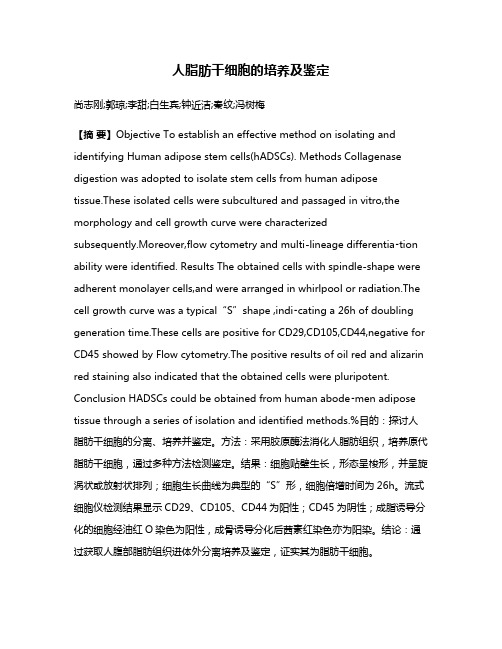
人脂肪干细胞的培养及鉴定尚志刚;郭琼;李甜;白生宾;钟近洁;秦纹;冯树梅【摘要】Objective To establish an effective method on isolating and identifying Human adipose stem cells(hADSCs). Methods Collagenase digestion was adopted to isolate stem cells from human adipose tissue.These isolated cells were subcultured and passaged in vitro,the morphology and cell growth curve were characterized subsequently.Moreover,flow cytometry and multi-lineage differentia⁃tion ability were identified. Results The obtained cells with spindle-shape were adherent monolayer cells,and were arranged in whirlpool or radiation.The cell growth curve was a typical“S”shape ,indi⁃cating a 26h of doubling generation time.These cells are positive for CD29,CD105,CD44,negative for CD45 showed by Flow cytometry.The positive results of oil red and alizarin red staining also indicated that the obtained cells were pluripotent. Conclusion HADSCs could be obtained from human abode⁃men adipose tissue through a series of isolation and identified methods.%目的:探讨人脂肪干细胞的分离、培养并鉴定。
人脂肪干细胞的生物学特性及分化研究
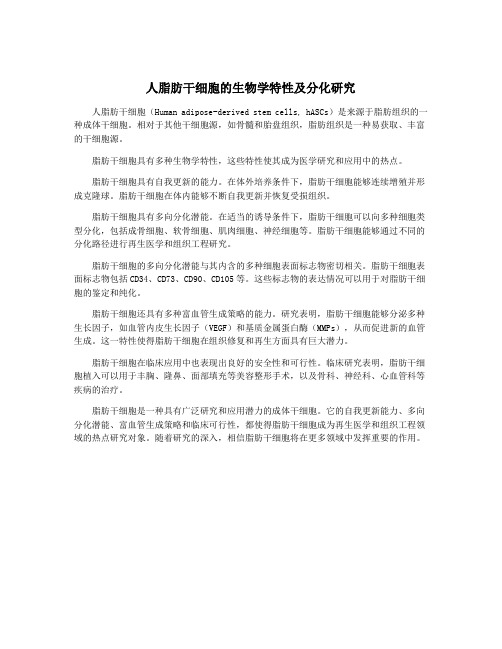
人脂肪干细胞的生物学特性及分化研究人脂肪干细胞(Human adipose-derived stem cells, hASCs)是来源于脂肪组织的一种成体干细胞。
相对于其他干细胞源,如骨髓和胎盘组织,脂肪组织是一种易获取、丰富的干细胞源。
脂肪干细胞具有多种生物学特性,这些特性使其成为医学研究和应用中的热点。
脂肪干细胞具有自我更新的能力。
在体外培养条件下,脂肪干细胞能够连续增殖并形成克隆球。
脂肪干细胞在体内能够不断自我更新并恢复受损组织。
脂肪干细胞具有多向分化潜能。
在适当的诱导条件下,脂肪干细胞可以向多种细胞类型分化,包括成骨细胞、软骨细胞、肌肉细胞、神经细胞等。
脂肪干细胞能够通过不同的分化路径进行再生医学和组织工程研究。
脂肪干细胞的多向分化潜能与其内含的多种细胞表面标志物密切相关。
脂肪干细胞表面标志物包括CD34、CD73、CD90、CD105等。
这些标志物的表达情况可以用于对脂肪干细胞的鉴定和纯化。
脂肪干细胞还具有多种富血管生成策略的能力。
研究表明,脂肪干细胞能够分泌多种生长因子,如血管内皮生长因子(VEGF)和基质金属蛋白酶(MMPs),从而促进新的血管生成。
这一特性使得脂肪干细胞在组织修复和再生方面具有巨大潜力。
脂肪干细胞在临床应用中也表现出良好的安全性和可行性。
临床研究表明,脂肪干细胞植入可以用于丰胸、隆鼻、面部填充等美容整形手术,以及骨科、神经科、心血管科等疾病的治疗。
脂肪干细胞是一种具有广泛研究和应用潜力的成体干细胞。
它的自我更新能力、多向分化潜能、富血管生成策略和临床可行性,都使得脂肪干细胞成为再生医学和组织工程领域的热点研究对象。
随着研究的深入,相信脂肪干细胞将在更多领域中发挥重要的作用。
人脂肪间充质干细胞的原代培养及体外成骨成脂诱导分化

人 脂 肪 间充 质 干 细胞 的原 代 培 养 及 体 外 成 骨 成 脂 诱 导 分 化
闵敏 , 张雪静 , 马红 , 许辉 , 李遇梅
( 1 . 江苏大学 附属 医院皮肤科 , 江苏 镇江 2 1 2 0 0 1 ; 2 . 镇 江市第 二人 民医院皮肤科 , 江苏 镇江 2 1 2 0 0 2 )
MI N Mi n , Z H A N G X u e - i f n g , MA H o n g , XU H u i , L I Y u . m e i
( 1 . D e p a r t m e n t o f D e r ma t o l o g y , A il f i a t e d H o s p i t a l o f J i a n g s u U n i v e r s i t y , Z h e n j i a n g J i a n g s u 2 1 2 0 0 1 ; 2 .D e p a t r me n t o f D e r ma t o l o y ,t g h e S e c o n d P e o p l e s Ho s p i t a l o f Z h e n j i a n g , Z h e n j i a n g J i a n g s u 2 1 2 0 0 2, C h i n a )
伴有成脂发生 。R T — P C R结 果显示 , 与对 照组相 比, 成脂诱 导组 P P A R y 一 2 m R N A有 时间依赖 性递增 表达 , 差异具 有统 计 学意义( P< 0 . 0 1 ) 。与对照组相 比, 成骨诱导组骨 桥蛋 白 , P P A R y 一 2 mR N A均有 时间依赖 性递增 表达 , 差异具 有统 计 学意义 ( P< 0 . o 1 ) 。结论 : 建 立了一种 分离培 养 h A D S C s 简 单可靠 的方法 。获得 的细胞 具有 贴壁 生长 、 增殖 活性
细胞成脂或成骨诱导的具体方法及注意事项

细胞成脂或成骨诱导的具体方法及注意事项
一、技术简介
干细胞和祖细胞群体存在于多种成体组织中,包括皮肤、肌肉、骨髓和脂肪。
越来越多的研究表明这些细胞可能具有多系分化的潜能,能够生成除来源组织以外的细胞类型。
近年来,人们发现成体脂肪组织可作为间充质干细胞另外一个丰富的来源。
这残细胞被命名为脂肪来源的干细胞(ASCs)。
在特定的培养条件下,ASCs可诱导分化为多种间充质和神经类型细胞。
二、实验流程
成骨诱导培养液配备与诱导操作
1. 准备含10%FBS的α-MEM培养液。
2. 在备好的α-MEM培养液中添加50μM抗坏血酸,10mM β-磷酸甘油和
100nM地塞米松。
3. 准备6孔培养板,将细胞接种于原始α-MEM培养液。
4. 每三天换液一次,细胞长至7天时进行碱性磷酸酶染色。
5. 28天后再进行矿化结节的茜素红染色。
成脂诱导培养液配备与诱导操作
1. 配置PBS10%含量的HG-DMEM培养液。
2. 在配置完成的HG-MEM培养液中加入10μM地塞米松、10μg/ml胰岛素、200μM吲哚美辛和0.5mM IBMX。
3. 准备6孔培养板,将细胞接种于原始HG-MEM培养液中。
4. 待细胞长至基本融合后,更换上述制备完成的成脂诱导培养液培养2天,在用只含有10μg/ml胰岛素的成脂维持培养液培养1天,如初交换培养至14天,使用红油O染色。
- 1、下载文档前请自行甄别文档内容的完整性,平台不提供额外的编辑、内容补充、找答案等附加服务。
- 2、"仅部分预览"的文档,不可在线预览部分如存在完整性等问题,可反馈申请退款(可完整预览的文档不适用该条件!)。
- 3、如文档侵犯您的权益,请联系客服反馈,我们会尽快为您处理(人工客服工作时间:9:00-18:30)。
中国组织工程研究 第19卷 第32期 2015–08–06出版Chinese Journal of Tissue Engineering Research August 6, 2015 Vol.19, No.32ISSN 2095-4344 CN 21-1581/R CODEN: ZLKHAH 5155www.CRTER .org肖建红,女,1980年生,四川省绵阳市人,羌族,2012年中山大学毕业,博士,主治医师,主要从事造血干细胞抑制、干细胞与组织工程,以及免疫性血小板减少性紫癜的临床研究和基础研究。
通讯作者:张阳春,硕士,主治医师,中山大学附属第一医院东院下肢骨科,广东省广州市 510700中图分类号:R394.2 文献标识码:A 文章编号:2095-4344 (2015)32-05155-07 稿件接受:2015-07-01 Xiao Jian-hong, M.D., Attending physician, Department of Internal Medicine, Eastern Branch of the First Affiliated Hospital of Sun Yat-sen University, Guangzhou 51000, Guangdong Province, ChinaCorresponding author: Zhang Yang-chun, Master, Attending physician, Department of Lower limbs Orthopedics, Eastern Branch of the First Affiliated Hospital of Sun Yat-sen University, Guangzhou 51000, Guangdong Province, ChinaAccepted: 2015-07-01人皮下脂肪干细胞的成骨、成脂分化诱导及鉴定肖建红1,张阳春2,张常然1,杨 兴2(中山大学附属第一医院东院,1普通内科,2下肢骨科,广东省广州市 510700)文章亮点:1 实验通过密度梯度离心和贴壁筛选法相结合,对人脂肪干细胞进行分离、体外培养及扩增。
2 实验发现第5代脂肪干细胞比较适合进行成脂及成骨诱导分化,以确定其多向分化潜能。
3 DAPI 是一种简单、有效的标记人脂肪干细胞的方法,DAPI 不损伤细胞活性,对细胞标记率高。
关键词:干细胞;脂肪干细胞;人来源的脂肪干细胞;细胞分化;脂肪组织;细胞培养;细胞鉴定;国家自然科学基金主题词:干细胞;皮下脂肪;细胞分化;细胞,培养的基金资助:国家自然科学基金青年项目(81500091);广东省自然科学基金博士启动项目(2015A030310022);广州市黄埔区科技计划项目(201444-02)摘要背景:脂肪干细胞是从脂肪组织中分离得到的一种具有多向分化潜能的间充质干细胞,在组织工程中比骨髓间充质干细胞具有更多优势,是当今的研究热点之一。
目的:在体外建立一种分离纯化人皮下脂肪来源脂肪干细胞的方法,进行体外培养扩增及诱导其向成骨、成脂细胞分化。
方法:通过密度梯度离心和贴壁筛选法相结合,对人脂肪干细胞进行分离、体外培养及扩增。
倒置显微镜下观察人脂肪干细胞的细胞形态和生长特性。
选取第2代及第5代细胞,用CCK-8法检测细胞活性,绘制细胞生长曲线,用流式细胞仪检测细胞表面抗原标记。
选取第5代细胞,分别进行成脂及成骨诱导分化,以确定其多向分化潜能。
结果与结论:①采用密度梯度离心和贴壁培养相结合方法,可成功从人脂肪组织中获得纯度较高的人脂肪干细胞。
②人脂肪干细胞经历了生长滞缓期、对数增殖期和生长平台期,符合正常细胞的生长规律,且其生长具有对数生长期,其倍增时间较短。
③人脂肪干细胞表达干细胞表面抗原标记,具有低免疫原性,且具有成脂成骨多向分化潜能。
④DAPI 是一种简单、有效的标记人脂肪干细胞的方法,DAPI 不损伤细胞活性,对细胞标记率高。
肖建红,张阳春,张常然,杨兴. 人皮下脂肪干细胞的成骨、成脂分化诱导及鉴定[J].中国组织工程研究,2015,19(32):5155-5161.doi:10.3969/j.issn.2095-4344.2015.32.013Human subcutaneous adipose-derived stem cells: osteoblastic/adipogenic differentiation and identificationXiao Jian-hong 1, Zhang Yang-chun 2, Zhang Chang-ran 1, Yang Xing 2 (1Department of InternalMedicine, 2Department of Lower limbs Orthopedics, Eastern Branch of the First Affiliated Hospital of Sun Yat-sen University, Guangzhou 51000, Guangdong Province, China)AbstractBACKGROUND: Adipose-derived stem cells are a kind of mesenchyam stem cells with multipotent differentiation capacity, which have more advantages than bone marrow mesenchymal stem cells in tissue engineering research. OBJECTIVE: To establish a method to isolate and purify adipose-derived stem cells from human subcutaneous adipose tissues followed by in vitro amplification and osteoblastic/adipogenic differentiation.METHODS: Adipose-derived stem cells were isolated from human subcutaneous adipose tissue and cultured by density gradient centrifugation and adherent culture. Cell morphology and growth features were observed under inverted microscope. Adipose-derived stem cells at passages 2 and 5 were selected for viability measurement using cell counting kit-8 method, and then cell growth curves were drawn. The immunophenotype identification was analyzed by flow cytometry. Passage 5 cells underwent osteoblastic/adipogenic induction to confirm the multi-differentiation potential.RESULTS AND CONCLUSION: (1) Using density gradient centrifugation and adherent culture method,high-purity human adipose-derived stem cells can be successfully isolated from human adipose tissues. (2) The growth process of human adipose-derived stem cells includes stagnant phase, logarithmic phase and plateau phase, which meets the growth rhythm of normal cells. Moreover, the population doubling time is shorter. (3).Human adipose-derived stem cells are positive for stem cell-related antigens, with low immunogenicity and themulti-differentiation potential. (4) Labeling human adipose-derived stem cells with DAPI is a simple efficient labeled method, and the labeling rate is high but the cytotoxicity is lowSubject headings: Stem Cells; Subcutaneous Fat; Cell Differentiation; Cells, CulturedFunding: the National Natural Science Foundation of China, No.81500091; the Natural Science Foundation of Guangdong Province, No.2015A030310022; the Scientific Plan of Huangpu District of Guangzhou City, No.201444-02Xiao JH, Zhang YC, Zhang CR, Yang X. Human subcutaneous adipose-derived stem cells: osteoblastic/adipogenic differentiation and identification. Zhongguo Zuzhi Gongcheng Yanjiu. 2015;19(32):5155-5161.0 引言 Introduction干细胞是人体及各种组织细胞的最初来源,具有高度自我复制、高度增殖和多向分化的潜能。
